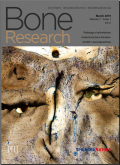- 钛学术文献服务平台 \
- 学术期刊 \
- 医药卫生期刊 \
- 外科学期刊 \
- 骨研究(英文版)期刊 \
Procalcitonin is expressed in osteoblasts and limits bone resorption through inhibition of macrophage migration during intermittent PTH treatment
Procalcitonin is expressed in osteoblasts and limits bone resorption through inhibition of macrophage migration during intermittent PTH treatment
基本信息来源于合作网站,原文需代理用户跳转至来源网站获取
摘要:
INTRODUCTION
Bone is a highly dynamic tissue that is remodeled throughout the lifespan. Bone turnover includes the degradation of old or damaged bone and the formation of new bone, which is carried out by two highly specialized cell types — osteoclasts and osteoblasts, respectively.1–2 Osteoblasts differentiate from mesenchymal stem cells, whereas osteoclasts form through the recruitment and fusion of macrophages.2 If the balance between bone formation and resorption is disturbed, osteoporosis, which is one of the most prevalent bone diseases in the aged population worldwide, may develop.

推荐文章
Carbazoles and benzocarbazoles confirm migration of leaked petroleum through caprocks and overlaying
Migration
Geochromatography
Leakage
North Sea
Valhall
Rare earth element chemistry indicates chemical alteration of zircons during the evolution of weathe
Weathering profile
Rare earth elements
Zircon
Iron isotope fractionation during fenitization: a case study of carbonatite dykes from Bayan Obo, In
Iron isotopes
Fenitization
Fluid exsolution
Carbonatite
Bayan Obo
甲状腺全切术对患者血清PTH的影响
甲状腺全切
甲状旁腺素
低钙血症
内容分析
关键词云
关键词热度
相关文献总数
(/次)
(/年)
引文网络
引文网络
二级参考文献 (0)
共引文献 (0)
参考文献 (0)
节点文献
引证文献 (0)
同被引文献 (0)
二级引证文献 (0)
2022(0)
- 参考文献(0)
- 二级参考文献(0)
- 引证文献(0)
- 二级引证文献(0)
引文网络交叉学科
相关学者/机构
期刊影响力
骨研究(英文版)
主办单位:
四川大学
出版周期:
季刊
ISSN:
2095-4700
CN:
51-1745/R
开本:
16开
出版地:
四川省成都市人民南路三段14号
邮发代号:
创刊时间:
2013
语种:
eng
出版文献量(篇)
264
总下载数(次)
0
总被引数(次)
428
期刊文献
相关文献
推荐文献

 免费查重
免费查重










